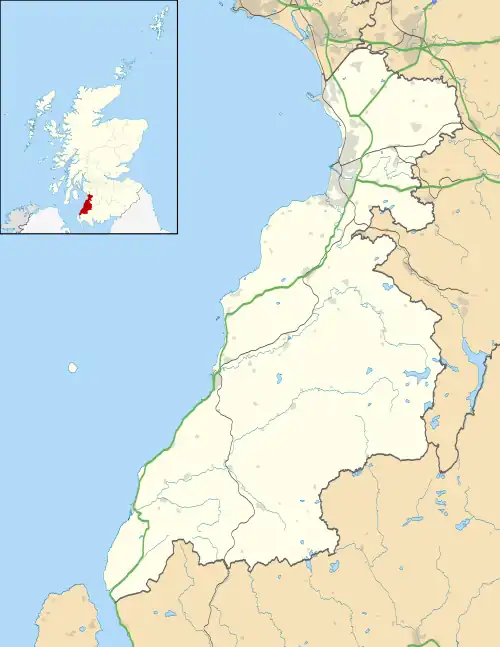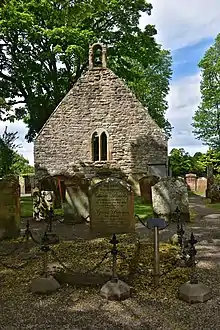| Alloway Auld Kirk | |
|---|---|
 | |
| Type | Church |
| Location | Alloway |
| OS grid reference | NS33191805 |
| Built | 16th century |
| Official name | Alloway Kirk |
| Type | Ecclesiastical: church |
| Designated | 5 July 1927 |
| Reference no. | SM308 |
Listed Building – Category B | |
| Official name | Alloway Kirk Graveyard including Hughes Mausoleum, Gatepiers, Gates and Boundary Wall and excluding Scheduled Monument No 308, 'Alloway Kirk', Alloway |
| Designated | 5 February 1971 |
| Reference no. | LB21471 |
 Location of Alloway Auld Kirk in South Ayrshire | |
The Alloway Auld Kirk, which dates back to the 16th Century,[1] is a ruin in Alloway, South Ayrshire, Scotland, celebrated as the scene of the witches' dance in the poem "Tam o' Shanter" by Robert Burns.

Robert Burns
William Burnes, father of the poet, is buried in the graveyard together with his daughter Isabella as well as two of his nieces.[2] Alloway was where he and his wife had first raised their family before moving to Mount Oliphant and Lochlea, and William had attempted to maintain the grounds of the Kirk, which was already a ruin at the time.[3] The original memorial stone has eroded and the present day stone differs in wording, memorializing both of Burns's parents, and includes an epitaph the poet wrote for his father.[3] Burns's sister, Isabella Burns Begg, is also buried in the Kirkyard, along with other notable figures such as David Cathcart, Lord Alloway.[1]
Robert Burns presented his friend John Richmond with a silver mounted snuffbox made with wood taken from the rafters of the Auld Alloway Kirk. The snuffbox bears the inscription;[4]
|
"Frae the oak that bare the riggin', |
A David Auld removed the remaining rafters and used them to make chairs and other souvenirs, making a considerable profit from the sales.[5]
Restoration and conservation
Following restoration work, the Kirk and graveyard were reopened to the public by Scottish First Minister Alex Salmond in April 2008.[6] The church itself is a scheduled monument and the churchyard a Category B listed building.[7][8]
See also
References
- 1 2 "Alloway Auld Kirk - Ayr - VisitScotland". www.visitscotland.com. Archived from the original on 24 November 2015. Retrieved 23 November 2015.
- ↑ "Wayback Machine". Archived from the original on 3 March 2016. Retrieved 21 August 2023.
- 1 2 Crawford, Robert (2009). The Bard. London: Jonathon Cape. p. 138. ISBN 9780224077682.
- ↑ Duncan, Robert (1910). The Story of the Edinburgh Burns Relics with Fresh Facts about Burns and his Family. Andrew Elliot. p. 34.
- ↑ Duncan, Robert (1910). The Story of the Edinburgh Burns Relics with Fresh Facts about Burns and his Family. Andrew Elliot. p. 35.
- ↑ Dailyrecord.co.uk (23 April 2008). "First Minister proud to re-open Auld Kirk". Daily Record. Retrieved 21 August 2023.
- ↑ Historic Environment Scotland. "Alloway Kirk (SM308)". Retrieved 19 February 2019.
- ↑ Historic Environment Scotland. "Alloway Kirk Graveyard including Hughes Mausoleum, Gatepiers, Gates and Boundary Wall and excluding Scheduled Monument No 308, 'Alloway Kirk', Alloway (Category B Listed Building) (LB21471)". Retrieved 19 February 2019.
External links
- Alloway Parish Church
- View of Alloway Kirk and surrounding Cemetery
- Video footage of St Mungo's Holy Well, Alloway, Ayrshire
- Video footage of the kirk and some insights into the Tam o' Shanter poem
- The Masonic Friendship that created Tam O’Shanter
This article incorporates text from a publication now in the public domain: Wood, James, ed. (1907). The Nuttall Encyclopædia. London and New York: Frederick Warne. {{cite encyclopedia}}: Missing or empty |title= (help)
55°25′40″N 4°38′15″W / 55.42786°N 4.63762°W